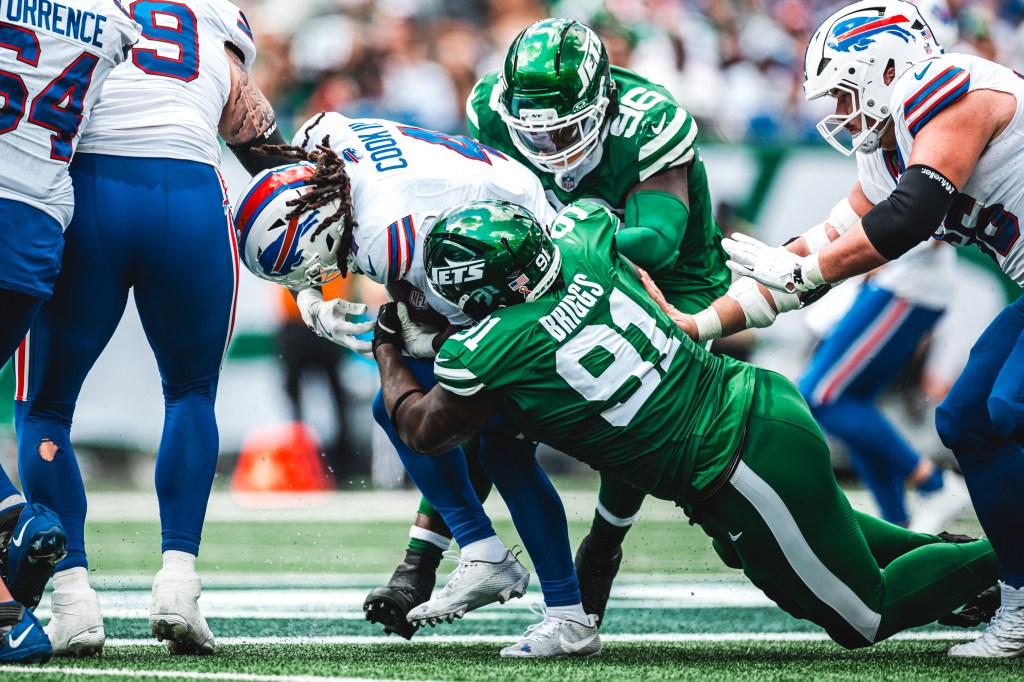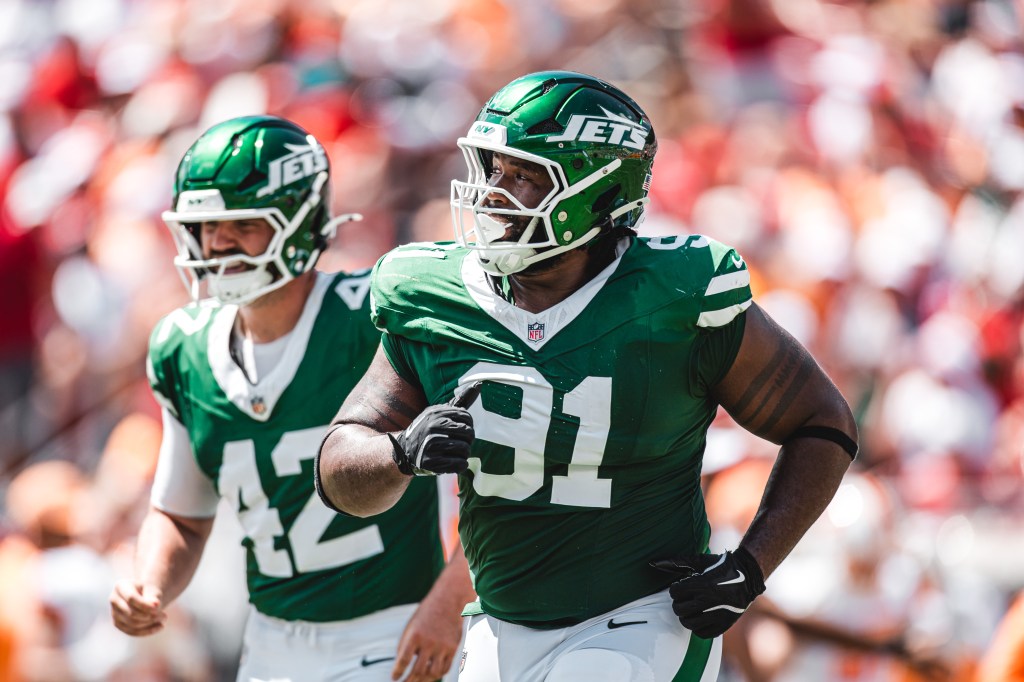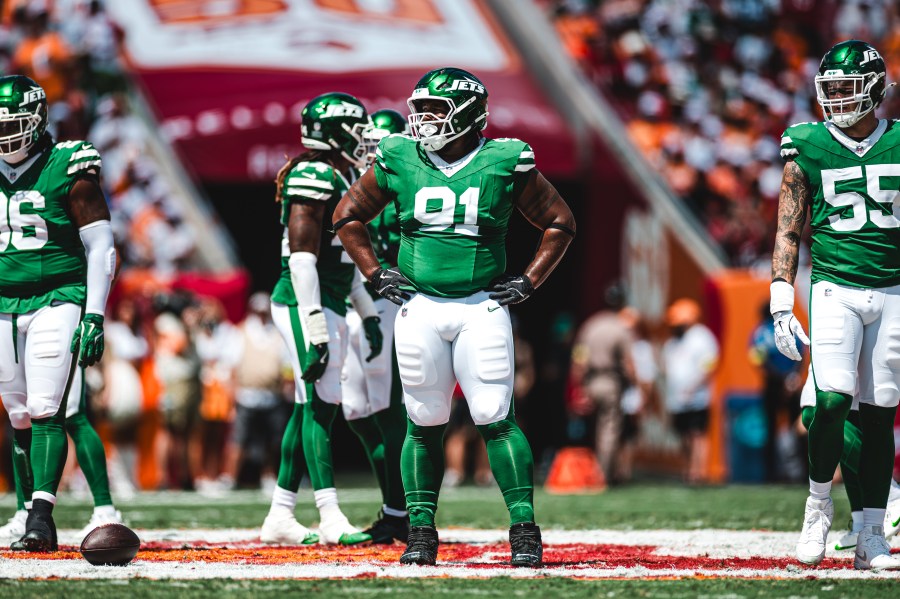New York Jets powerhouse Jowon Briggs on building real-world strength through movement, power, and recovery
New York Jets defensive lineman Jowon Briggs is built for impact – explosive from the first step and relentless to the whistle. But behind that power lies precision, discipline, and a science-driven approach to training, recovery, and nutrition. Briggs insists he’s mentally tough too. He needs to be, as the Jets have had an atrocious start to this NFL season, including a recent 13-11 defeat to Denver Broncos at the Tottenham Stadium. But as the NFL’s reach grows across the Atlantic, Men’s Fitness was still able to catch up with Briggs to break down how he maintains that rare balance of size, speed, and stamina.
Men’s Fitness: Jowon, you’re known for your explosiveness off the line. What kind of training helps you maintain that power throughout the season?
Jowon Briggs: The first thing that comes to mind is Olympic lifting. I’ve always been a big fan of clean pulls, power cleans, and any kind of jerk movement. Those are perfect for developing that kind of full-body explosiveness we need in football.
As a defensive lineman, I’m in a bent-knee stance most of the time – loading through the legs, exploding from my heels through my hips, and finishing with my hands. A power clean mirrors that exactly. It’s about transferring strength into speed and control, which is what the game’s all about.

MF: For the uninitiated UK viewer, rugby’s probably the closest thing we’ve got to the NFL here. Would you say your kind of training translates well to that sport too?
JB: Absolutely. The movements and the power demands are really similar. Even simple lifts like dumbbell presses or bench press reinforce the striking motion you need in both sports. It’s not just about how much force you can produce, but how effectively you can apply it. Using your hands properly and staying strong through contact – that’s universal.
MF: How much of that power work can you realistically keep up during the playing season?
JB: Most of the real work happens before the season starts. The season itself feels like it flies by – the games are just a fraction of the overall grind. In the NFL, we play 18 regular-season weeks, maybe 20-plus games if you go deep. But there are 300-plus other days spent getting your body ready to perform at that level.
MF: How do you structure your training with that in mind?
JB: We break it into phases. Phase one is the ramp-up – reintroducing lifts and sprints, getting the body moving again. Phase two is the heavy block: lower reps, heavier weights, longer runs. That’s where the real gains happen. Then phase three is the peak – the weights stay heavy, the reps drop, and the running gets sharper and faster. By the time you hit training camp, your body’s tuned to perform optimally for those 20 or so games.
MF: What kind of running distances are we talking about for a big guy like you?
JB: For linemen, it’s mostly about plyometric bursts – short, powerful sprints. We’ll do a lot of 10s, 20s, 30s. But endurance still matters. We’ll throw in 80-yard or 110-yard strides, just to keep the lungs and legs conditioned.
You’ll run 80 yards, rest, then go again – it’s not about top speed, it’s about sustaining effort. If I’m training on my own, I focus on those shorter, explosive sprints. But when we’re in a team setting, we do longer runs too, to make sure the conditioning’s there for four quarters.
MF: Is there any part of training you dread?
JB: (laughs) Honestly, I love lifting – legs, upper body, whatever. And I’ve always loved sprinting. But back in college, I hated the long-distance stuff – those 300-yard shuttles were rough.
Now, I’ve come to appreciate it. You realise how much better your body feels through the season when you’ve put in that base. If I only train for two- or three-second bursts, what happens when a play runs seven seconds? I’m cooked. So, I train my body for the worst-case scenario. You don’t have to love it, but you respect what it gives you.

MF: Let’s talk recovery – what’s your go-to after a game?
JB: Recovery’s everything. There’s some new research saying cold plunges right after a game help blunt inflammation and kickstart recovery. Some guys swear by it – me, I know it works, but I’m not a big fan of the cold (laughs).
I’m more of a compression guy. I use the leg compression sleeves or boots – they get the blood flowing, help your legs recover faster. I’ll usually do that, take a hot bath, then go back to compression again. After that, I’ll hit any tight spots with a massage gun.
For me, it’s all about promoting circulation. The more you can keep that blood moving, the faster your body bounces back. You can’t perform at your best if you’re not recovering at your best.
MF: What about nutrition – what fuels you before and after games?
JB: I’m a light eater before games. Some guys can eat big, but I like to carb-load without overdoing it. You want energy, but you don’t want to feel heavy. So, it’s pancakes, oatmeal, maybe some eggs and sausage if it’s an early game, but not too much protein. Protein sits in your stomach.
Electrolytes are huge too. We use this salty mix that’s loaded with magnesium, sodium, zinc – you throw it in your water and it helps balance everything out before kickoff. That keeps the cramping away and helps your hydration.
After games, I focus on recovery foods – collagen for bone health, fish oil, tart cherry juice to fight inflammation. I’ll hydrate, rest, and keep my legs elevated. It’s about reducing that internal stress so you can go again the next day.
MF: Finally, what are your personal goals this season – and what do you want to see from the team?
JB: For the team, I want us to keep executing. The NFL is all about details – one guy being half a step out of position can decide a win or a loss. So, we’ve got to be locked in 100 percent of the time. If we do that, we’ll achieve big things.
Personally, I want to mirror that same focus – be the guy who’s always doing the right thing, always setting the standard. That’s how you move the whole ship in the right direction.
MF: And for our readers – what’s one piece of advice you’d give to guys who want to train like an NFL player?
JB: Focus on movement, not just muscle. Don’t train to look strong – train to be strong. Do lifts that build power through your whole body, like cleans and jumps. Sprint. Move explosively. And don’t skip recovery – that’s where you really grow. Everyone wants to go hard, but the pros know when to rest so they can go harder tomorrow. That’s the difference.
Credit: Images New York Jets.
To stay updated on the latest news about the New York Jets and follow the journey throughout the 2025 season, visit nyjetsinternational.com or @NYJetsinUKandIE on X and @newyorkjetsinuk on Instagram.







